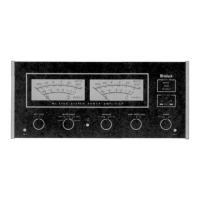1.
Unless otherwise
spec
ified:
Resistance values
are in
ohms,
1/4
watt,
and 10% to
1erance;
capacitance values sma llr than 1 a re in microfarads (µF) : capacitance values greater
than 1 are in picofarads (pF); inductors are in microhenries (µH).
2 . Printed circuit board components a re ou t1i ned on the schema tics by dotted lines. The
c i rcled numbers on the dotted lines correspond to the numbers on the PC board layouts.
3. The heavy li nes on the schema tics denote the pr ima ry signal path.
4. The terminal number ing of rotary switches is for reference only.
5. All voltages i nd i cated on the schemat i cs a re measu red under the fo11owi ng cond i t i ons;
a. Use of an 11 megohm impedance VTVM.
b. All voltages ± 10% with respect to chassis ground.
c. No signal at input terminals.
d. AC
input
at 120
volts
AC,
50/60Hz.
e. Front pane l con t rols at: Rear panel swi tches a t:
Left Gain FULLY CCW Input Level 0.75V
Meter Range WATTS Mode S tereo
Right/Mono Gain FULLY CCW Power Guard Normal
Speakers ON
Power ON
6. Relay K301 shown in energized pos i t i on.
7. Meter adjustments:
Amplifier
must
be
working properly
to
adjust meters.
Ope
rate
amplifier
at
full
power
(40V rms)
into 8 ohm loads with 1 KHz input signal.
a. Set METER RANGE switch to WATTS.
b. Adj us t pot en t i ometer R125 on meter board for a reading of 200 watts on the left meter.
c. Adjust R126 for a reading of 200 watts on the right meter.
d. Set METER RANGE switch to 0 dB
e. Adjust potenti ometer R105 on meter board for a reading of 0 on the DECIBEL scale of the
left meter.
f. Adjust RI06 for a reading of 0 on the right meter.
8. Power amplifier bias adjustment:
Operate
MC
2205
at 120
volts
line
input
with
no
input
signal.
Measure
the
input
power
(approximately 50 watts) or current (approximately O.4 amps). The bias potentiometers R241 &
R242 are located on the power output PC boards.
a. Turn both bias potentiometers f u l l ccw
b.
Rotate
bias
ad jus
tment
cw to the
point
where
the
line
input
power
or
current
begins
to
i
ncrease
then
back
off
slightly
to the
point
where
the
line
in put
reaches
its l
owest
va l ue .
c . Repeat step b for each channel independently.
SCHEMATIC NOTES
MC2205

